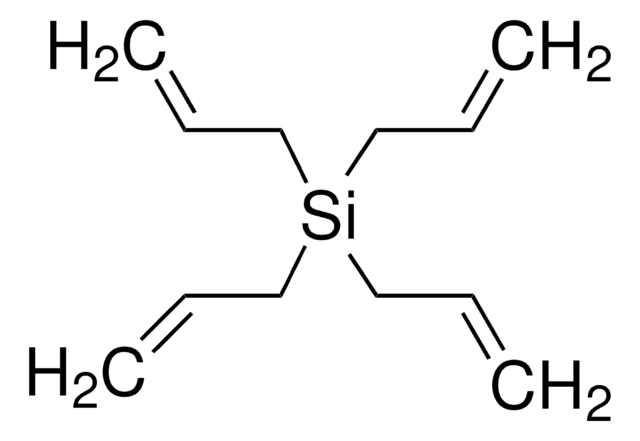396281
2,4,6,8-Tetramethyl-2,4,6,8-tetravinylcyclotetrasiloxane
Synonym(s):
2,4,6,8-Tetraethenyl-2,4,6,8-tetramethylcyclotetrasiloxane
About This Item
Recommended Products
form
liquid
refractive index
n20/D 1.434 (lit.)
bp
111-112 °C/10 mmHg (lit.)
mp
−44 °C (dec.) (lit.)
density
0.997 g/mL at 25 °C (lit.)
SMILES string
C[Si]1(O[Si](C)(O[Si](C)(O[Si](C)(O1)C=C)C=C)C=C)C=C
InChI
1S/C12H24O4Si4/c1-9-17(5)13-18(6,10-2)15-20(8,12-4)16-19(7,11-3)14-17/h9-12H,1-4H2,5-8H3
InChI key
VMAWODUEPLAHOE-UHFFFAOYSA-N
Related Categories
General description
Application
- Cyclic siloxanes conjugated with fluorescent aromatic compounds as fluoride sensors: This study explores the use of cyclic siloxanes conjugated with aromatic compounds for sensing applications, offering a pathway for academic chemists interested in sensor technology and fluorescence studies (N Prigyai et al., 2020).
- Synthesis, film morphology and performance of novel crosslinked polysiloxane with end-capped epoxy groups on cotton substrates: This article examines the chemical modification of cotton substrates using polysiloxane derivatives, which can be crucial for developing advanced textile coatings (L Hao et al., 2014).
- Stabilizing Li-rich layered oxide cathode interface by using silicon-based electrolyte additive: This research investigates the use of a silicon-based additive derived from 2,4,6,8-tetramethyl-2,4,6,8-tetravinylcyclotetrasiloxane to enhance the stability of lithium-rich cathodes, important for chemists working with energy storage technologies (T Huang et al., 2024).
Signal Word
Danger
Hazard Statements
Precautionary Statements
Hazard Classifications
Repr. 1B
Storage Class Code
6.1C - Combustible acute toxic Cat.3 / toxic compounds or compounds which causing chronic effects
WGK
WGK 1
Flash Point(F)
190.4 °F - closed cup
Flash Point(C)
88 °C - closed cup
Personal Protective Equipment
Certificates of Analysis (COA)
Search for Certificates of Analysis (COA) by entering the products Lot/Batch Number. Lot and Batch Numbers can be found on a product’s label following the words ‘Lot’ or ‘Batch’.
Already Own This Product?
Find documentation for the products that you have recently purchased in the Document Library.
Customers Also Viewed
Our team of scientists has experience in all areas of research including Life Science, Material Science, Chemical Synthesis, Chromatography, Analytical and many others.
Contact Technical Service










